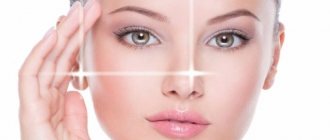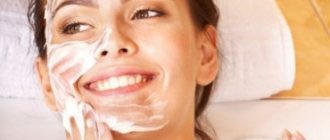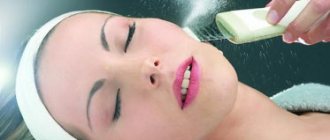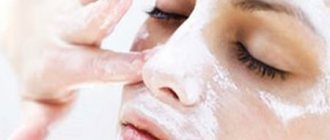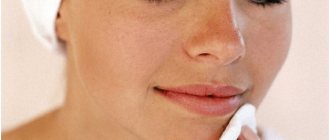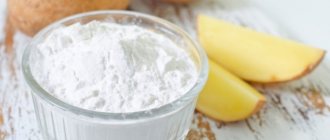Enzyme peeling is considered to be one of the most gentle peeling options. Therefore, it is not surprising that this procedure is suitable for all skin types, including sensitive skin, which is particularly “capricious” when it comes to exfoliating procedures. What is his secret? The fact is that enzyme peeling does not use acids and abrasive (“scratching”) particles, but enzymes that quite gently remove dead skin cells. How? Enzymes, getting on the skin, destroy the substance that binds dead scales, due to which they are easily removed. How does enzyme peeling work on the skin, what processes does it stimulate, what are its advantages and disadvantages? You can find the answers to these questions below.
So, we know that all peelings are aimed at eliminating dead skin cells that clog pores, lead to peeling and other unpleasant consequences. But frequent and aggressive peelings, in most cases, do not have the best effect on our skin. And if you get carried away and carry out peelings incorrectly more than once a week, then you can completely disrupt the protection of the skin layer ( hydrolipid barrier ), and this will lead to skin dehydration, peeling, redness, inflammation and acne. Therefore, you need to be especially careful with peelings, especially with those that have abrasive particles. After all, you must admit, we have all heard and seen on the Internet various peeling recipes at home based on crushed coffee or rice beans, crushed apricot kernels, oatmeal... In most cases, they are absolutely unsuitable for the skin and damage it.
As an alternative to “scratching” peels, you can use safe enzyme-based products. And as we have already discussed above, they simply break the connections between the scales, which are easily removed after this. In addition, this version of the procedure has an excellent effect on the skin: it cleanses pores, lightens age spots and acne, and stimulates skin renewal processes (the “birth” of new cells). Enzyme peeling is also one of the few that cleans pores as deeply as possible. Why? Let's imagine that time is a “dimple” in the skin in which dead cells are located. If you use peeling with any hard particles, then these particles pass along the surface of the skin, removing the top layer, but due to their size they are not able to get into the “pits”. Accordingly, the procedure was completed, some of the keratinized cells were removed, and the other part remained in the pores. And pores clogged with sebaceous secretions and dead cells become inflamed over time, resulting in acne (blackheads) and blackheads. That’s why enzyme peeling is the best option for deep cleansing pores and preventing acne. And if you have problem skin prone to acne and blackheads, take note of enzyme peels, because they can significantly improve your situation.
After peeling in the salon, other procedures and cosmetics will work much better. After all, its penetration will not be hindered by keratinized cells tightly covering the skin.
In addition, a nice bonus is that enzyme peeling slows down and reduces facial hair growth. By the way, enzymatic hair removal , which involves applying an enzyme preparation and warming the skin. Enzymes destroy the bonds in the hair follicle, and the hair weakens and is then removed. But you should not try to remove excess facial hair in this way - it is unsafe, as it requires keeping the product on the skin for a longer time. And the skin of the face is too delicate and thinner for this type of hair removal. Therefore, peeling will not completely remove hairs, but if you use the service of epilation of certain areas of the face, then enzyme peeling will help you maintain the result longer. This is not its main function, but for many girls it is very useful.
Enzyme peeling shows results already in the first procedure - the skin becomes cleaner, smoother, the relief is evened out, pigment spots and acne marks are lightened. Each subsequent peeling procedure improves this result. The only thing is that in terms of eliminating the consequences of acne, you should not expect an immediate significant result. After all, there are no cosmetic products yet that would eliminate red spots in one procedure that have been on the skin for quite a long period of time and have not gone away on their own. But as for acne and acne, the result will definitely be a reduction in the number of acne and their lightening, if you follow the correct care recommended by a cosmetologist. If you combine peeling with daily cleansing and moisturizing of the skin, you will see significant changes in just 2-3 weeks. This applies to cases where the cause of acne is external (otherwise you can “put things in order”, and after a few weeks the rashes will appear again due, for example, to increased hormone levels). You can read more about the causes and methods of treating acne here.
The advantage of enzyme peeling over others is that it can be used at any time of the year. After all, many of us know that the majority of “scratching” and deep peels are not recommended for use in the summer due to subsequent exposure to the sun on the skin, which will worsen the condition and can provoke pigmentation. Enzyme peels, in turn, are absolutely safe for use in the summer. Although, to protect the skin, it is still worth applying a cream with an SPF of at least 30 after the procedure.
Regarding restrictions, you should not apply peeling to the entire skin more than once a week (this will not improve, but will worsen the result, do not neglect this rule) and for a longer period than 2 minutes, since if you keep it longer, it will also will not benefit the skin. Although in some cases (taking into account the condition of your skin), cosmetologists recommend applying enzyme peeling twice: once to the entire skin of the face and once to individual areas of the skin with severe post-acne.
Now let's summarize the above.
How enzymes work
Enzymes are substances that can accelerate or slow down biochemical reactions, including those occurring in skin cells. For peeling, enzymes are used that accelerate the breakdown of proteins, because the primary task of any peeling is to get rid of dead cells and metabolic products that have a protein structure.
Enzymes added to cosmetic products are obtained from plant materials. They are rich in pineapples, sugar cane, kiwi, grapes, wheat, papaya, pumpkin and aloe vera. Often, to increase the effectiveness of the procedure, enzymes are supplemented with fruit acids; such mixes help improve the condition of skin with post-acne, small scars and even age spots.
Peeling stages
- Preparatory – consultation with a specialist, collection of anamnesis, identification of possible contraindications, compliance with recommendations – exclusion of medications with retinol, active insolation and skin trauma for 3-5 days before the procedure.
- Allergological - sensitivity test. Apply the enzyme mixture to the elbow or inner wrist for up to 20 minutes, followed by assessment for the absence or presence of redness or irritation.
- Cleansing - make-up removal and toning of the skin.
- The main one is the use of the composition. The selection of enzymes takes into account the characteristics of the skin. The components are applied with a flat brush in direct sequence: face-cheeks-chin-nose-neck-décolleté or with a spatula on the body. To enhance the work, massage-brushing is performed on top of the peeling, followed by the application of cling film or a warm compress with an exposure time of 15-30 minutes.
- The final step is rolling or rinsing with warm water. Alkaline neutralization is carried out in the presence of acids in the compositions.
- Post-procedure - use of a nourishing mask, serum, moisturizers and sunscreens with SPF from 15. For example, cream block for tanning and age spots, SPF 45.
Important Steps
- Restoring water balance and saturating cells with oxygen.
- Stimulating regeneration - rejuvenation, lifting and normalization of dermal structures.
- Tissue renewal - delicate dissolution and exfoliation of epidermal cells.
- Evens out skin texture and gently lightens age spots.
- Cleansing and tightening pores.
- The formation of new collagen and elastin fibers is stimulation of fibroblasts.
- Removing surface toxins and improving the absorption capacity of the skin.
- Improving microcirculation and stimulating the production of new blood vessels.
- Renewal of the lipid barrier and reformation of epidermal metabolism.
How to do enzyme facial peeling
Enzyme peeling begins with cleansing with special tonics and lotions developed taking into account the characteristics of the peeling preparation. A solution is then applied to the skin to improve skin permeability. Up to five different drugs may be involved in this stage. Next, the skin of the face, neck and décolleté is covered with a peeling composition. By the way, there are drugs that can be used to cleanse the skin of the eyelids and lips. Exposure time is 10-30 minutes, the procedure is accompanied by a slight tingling sensation. After exposure, the working composition is neutralized with a special solution and washed off with water. After cleansing, a soothing mask is applied to the facial skin, and at the very end of the procedure, a moisturizing cream with UV filters is applied.
The skin after enzyme peeling does not require special care, but it should not be exposed to direct sunlight, and to prevent damage from accidental exposure, it is recommended to constantly use sunscreen.
If the skin is dry, enzyme peeling is done once a week; for oily skin, the number of procedures can reach 2-4 per week. The cosmetologist will determine how many enzyme peeling sessions are needed. You can repeat the course in six months.
Indications
- Oily and seborrheic skin: comedones, enlarged pores, mild acne as part of complex therapy.
- Prevention of premature age-related changes.
- Correction of the initial signs of chronoaging: facial wrinkles, dull color, uneven relief.
- Sensitive skin with a tendency to inflammation and irritation.
- Cuperosis is a vascular “mesh”.
- Photoaging - decreased tone, elasticity, dryness of the skin.
- Hyperkeratosis is increased keratinization of the epidermis.
- Superficial hyperpigmentation of the face and body.
- Preparation for deep and aggressive methods of influence: plastic surgery, laser resurfacing, microneedling, chemical peels.
Contraindications
- Pregnancy (1st trimester).
- Viral and fungal processes - herpes, ARVI, microsporia.
- Increased body temperature.
- Violations of the integrity of the skin: wounds, burns, pustular lesions.
- Exacerbation of chronic dermatoses: psoriasis, eczema.
- Benign and malignant neoplasms.
- Severe pathologies of the hematopoietic and endocrine systems.
- Autoimmune diseases: scleroderma, systemic lupus erythematosus.
- Fresh tan - less than 14 days.
- Individual intolerance to components.
How much does enzyme peeling cost? Price of enzyme peeling in the salon
Enzyme peeling is recommended to be carried out in the salon. An experienced cosmetologist will correctly assess the condition of the skin, select the right composition, and create a program for cleansing and rejuvenating the skin. The price of one enzyme peeling procedure depends on the drug used and the level of the cosmetology establishment. On average, in Moscow you will have to pay from 600 to 3,500 rubles . To achieve the desired effect, it is rarely possible to limit yourself to one procedure; more often, 2-3 are required (before sessions.
To achieve the desired effect, it is rarely possible to limit yourself to one procedure; more often, 2-3 are required (before sessions.
Definition of the concept
Enzymes are molecules with a protein structure that are found in the skin and human body to enhance metabolic mechanisms and break down complex substances. A cosmetic “cocktail” of natural ingredients loosens dead horny layers and exfoliates cells without damaging the protective barrier.
Enzyme peeling is a superficial and gentle procedure for chemical cleansing of the skin, which has been used for more than 50 years to rejuvenate, relieve inflammation, remove protein impurities and increased secretions of the sebaceous and sweat glands based on non-aggressive enzymes. Active preparations are created using advanced technological cleaning to care for sensitive, problematic or dry skin.
Enzyme peeling: home procedure
If it is not possible to visit a cosmetologist, enzyme peeling can be done at home. For the procedure, you should use ready-made medications, which you can buy at the pharmacy. An analysis of reviews of enzyme peels intended for home procedures allows us to conclude that the most popular are:
enzyme peeling Stopproblem (Russia). By the way, this drug is also used by professionals. In addition to enzymes, salicylic acid is added to the StopProblem peeling, which makes this composition relevant for oily skin with comedones. The procedure should be performed in accordance with the instructions (pay attention to contraindications!); after peeling, it is not recommended to apply decorative cosmetics for 24 hours. Salicylic enzyme peeling Stopproblem, according to reviews, perfectly cleanses the skin, but is not suitable for sensitive oily skin.
Enzyme peeling Janssen (Germany) . The composition of this popular product includes: enzymes obtained from papaya and pineapple, as well as clay (kaolin). Unlike Stopproblem enzyme peeling, Jansen peeling is suitable for any skin type. You can buy Jansen enzyme peeling in beauty salons that have the right to work with this cosmetics (Janssen is a brand of professional cosmetics for skin care).
GR Enzyme Peeling GIGI ( Israel ). This enzyme peeling regulates the functioning of the sebaceous glands and gently cleanses the skin. The drug has pronounced anti-inflammatory and antibacterial properties and lightens the skin quite well. In addition, peeling from GIGI improves skin permeability and promotes better absorption of caring cosmetics.
The mechanism of enzyme work
- Enzymes are specific protein substances that are catalysts - amplifiers of redox and metabolic processes and affect the rate of chemical reactions in all living organisms.
- There are more than 5,000 unique enzymes in the form of 6 different groups. In cosmetology, hydrolases are widely used - enzymes that break down substances with the help of water: proteases (break down protein accumulations), lipases (break down fat), carbohydrases (break down carbohydrates).
- The stratum corneum contains proteases that are responsible for the renewal and breakdown of proteins, regulation of metabolic mechanisms in keratinocytes - the main cells of the epidermis, destroy intercellular connections - desmosomes, and form the lipid base.
- Over time, the activity of proteases to destroy the bonds between the scales decreases, which leads to a thickening of the epidermis, a lumpy structure and the formation of an insufficient level of hydration. To normalize cellular processes in these cases, enzyme peels are used.
- Enzyme compositions dissolve dead cells of the epidermis, destroy the protein - keratin in the upper stratum corneum and break down the functional connections between cells. As a result, delicate exfoliation, renewal, normalization of microcirculation, cellular respiration and texture alignment occur.
Clinical examples
Patient, 28 years old, sensitive skin, phototype II. There are dense zones with areas of seborrhea, vascular reactivity and facial wrinkles are present.
Directions for use: peelings using plant and bacterial enzymes and a regenerating home care system with sunscreen.
Result: after 8 procedures, once every 12 days, the skin was smoothed, wrinkles and redness were reduced.
Patient, 33 years old, phototype III. There is superficial pigmentation and uneven skin tone with enlarged pores.
Directions for use: enzyme brightening, restorative mixtures and home care with moisturizing and anti-inflammatory components.
Result: lightening of hyperpigmented areas, narrowing of pores, restoration of skin color after a 12-week course.
Advantages and disadvantages
Who should do enzyme peeling and who shouldn't? What are its disadvantages and advantages?
This procedure is indicated primarily for those young ladies who have problem skin: enlarged pores, a tendency to acne, blackheads, age spots... In addition, it is suitable for girls with sensitive, dull skin prone to irritation. And, of course, to those women whose faces are affected by the first signs of aging.
Contraindications to enzyme peeling are as follows:
- individual intolerance to one of the components;
- active herpes, fungal diseases of the facial skin;
- acne during exacerbation;
- sores, warts, scratches or cuts on the face.
Enzyme peeling is suitable for all skin types
So why is enzyme peeling so good? Why does it outperform other similar cosmetic procedures?
Firstly, this peeling is gentle and does not require a rehabilitation period. Secondly, it is suitable for all skin types. Thirdly, it can be done at any time of the year. Fourthly, it gives an instant effect. Fifthly, after the doctor’s consent, it can be carried out even for a pregnant woman or nursing mother.
And another undeniable plus is the ability to do enzyme peeling at home.
The downside is that it is still superficial, which means it is not able to get rid of deep wrinkles. In addition, enzyme peeling should not be overused, so as not to dry out the skin and deprive it of its natural protection.
